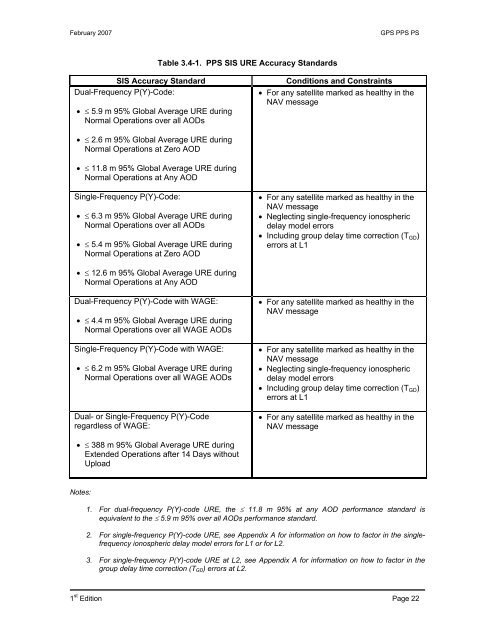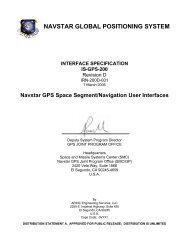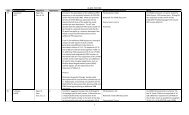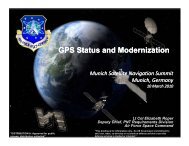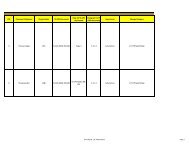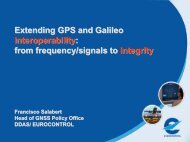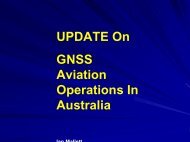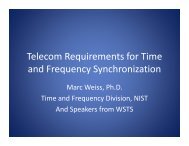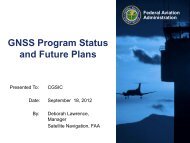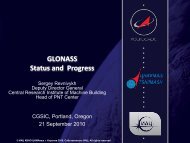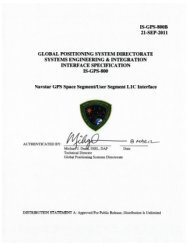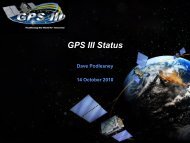Precise Positioning Service Performance Standard - GPS.gov
Precise Positioning Service Performance Standard - GPS.gov
Precise Positioning Service Performance Standard - GPS.gov
You also want an ePaper? Increase the reach of your titles
YUMPU automatically turns print PDFs into web optimized ePapers that Google loves.
February 2007<br />
<strong>GPS</strong> PPS PS<br />
Table 3.4-1. PPS SIS URE Accuracy <strong>Standard</strong>s<br />
SIS Accuracy <strong>Standard</strong><br />
Dual-Frequency P(Y)-Code:<br />
• ≤ 5.9 m 95% Global Average URE during<br />
Normal Operations over all AODs<br />
Conditions and Constraints<br />
• For any satellite marked as healthy in the<br />
NAV message<br />
• ≤ 2.6 m 95% Global Average URE during<br />
Normal Operations at Zero AOD<br />
• ≤ 11.8 m 95% Global Average URE during<br />
Normal Operations at Any AOD<br />
Single-Frequency P(Y)-Code:<br />
• ≤ 6.3 m 95% Global Average URE during<br />
Normal Operations over all AODs<br />
• ≤ 5.4 m 95% Global Average URE during<br />
Normal Operations at Zero AOD<br />
• For any satellite marked as healthy in the<br />
NAV message<br />
• Neglecting single-frequency ionospheric<br />
delay model errors<br />
• Including group delay time correction (T GD )<br />
errors at L1<br />
• ≤ 12.6 m 95% Global Average URE during<br />
Normal Operations at Any AOD<br />
Dual-Frequency P(Y)-Code with WAGE:<br />
• ≤ 4.4 m 95% Global Average URE during<br />
Normal Operations over all WAGE AODs<br />
Single-Frequency P(Y)-Code with WAGE:<br />
• ≤ 6.2 m 95% Global Average URE during<br />
Normal Operations over all WAGE AODs<br />
Dual- or Single-Frequency P(Y)-Code<br />
regardless of WAGE:<br />
• For any satellite marked as healthy in the<br />
NAV message<br />
• For any satellite marked as healthy in the<br />
NAV message<br />
• Neglecting single-frequency ionospheric<br />
delay model errors<br />
• Including group delay time correction (T GD )<br />
errors at L1<br />
• For any satellite marked as healthy in the<br />
NAV message<br />
• ≤ 388 m 95% Global Average URE during<br />
Extended Operations after 14 Days without<br />
Upload<br />
Notes:<br />
1. For dual-frequency P(Y)-code URE, the ≤ 11.8 m 95% at any AOD performance standard is<br />
equivalent to the ≤ 5.9 m 95% over all AODs performance standard.<br />
2. For single-frequency P(Y)-code URE, see Appendix A for information on how to factor in the singlefrequency<br />
ionospheric delay model errors for L1 or for L2.<br />
3. For single-frequency P(Y)-code URE at L2, see Appendix A for information on how to factor in the<br />
group delay time correction (T GD ) errors at L2.<br />
1 st Edition Page 22


